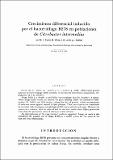Por favor, use este identificador para citar o enlazar a este item:
http://hdl.handle.net/10261/22131COMPARTIR / EXPORTAR:
 SHARE
BASE SHARE
BASE
|
|
| Visualizar otros formatos: MARC | Dublin Core | RDF | ORE | MODS | METS | DIDL | DATACITE | |

| Campo DC | Valor | Lengua/Idioma |
|---|---|---|
| dc.contributor.author | Fusté, M. C. | - |
| dc.contributor.author | Viñas, M. | - |
| dc.contributor.author | Lorén, J. G. | - |
| dc.contributor.author | Guinea, J. | - |
| dc.date.accessioned | 2010-03-09T11:39:25Z | - |
| dc.date.available | 2010-03-09T11:39:25Z | - |
| dc.date.issued | 1980 | - |
| dc.identifier.citation | An. Estac. Exp. Aula Dei 15 (1/2): 138-147 (1980) | en_US |
| dc.identifier.issn | 0365-1800 | - |
| dc.identifier.uri | http://hdl.handle.net/10261/22131 | - |
| dc.description.abstract | [EN] Phage B278 is a double strand DNA bacteriophage that fits Bradley's A group. When phage B278 lysates are assayed for plate forming ability on Citrobacter intermedius C3, 3MA2 and 1230 strains, colony-like foci of growth, called "excrescences" of indicator strain appear instead of lytic plaques. These "excrescences" are constituted by bacterial cells showing no morphological differences with the wild type. However the "excrescence" cultures, both in mineral and in nutritive media show higher generation times than the generation times od wild type strains cultures. An interpretation of the experimental results is suggested. Along the work is also considered the possible use of phage B 278 as a model system for the study of the host cell-virus relationship. | en_US |
| dc.description.abstract | [ES] En este trabajo se estudia un aspecto peculiar de la interacción del bacteriófago B278 sobre C. intermedius C3, C. intermedius 1230 y C. intermedius 3MA2. El bacteriófago B278 induce, cuando infecta en las condiciones que se describen en el trabajo, a las cepas antes citadas la formación de unas excrecencias. Estas excrecencias formadas por poblaciones de la cepa indicadora presentan un tiempo de generación netamente superior. Asímismo, una fraccion de la población de las excrecencias pierde los marcadores auxotróficos que llevaba la cepa salvaje, recuperando su capacidad de formar colonias en medio mínimo. En el trabajo se analizan los resultados experimentales obtenidos planteando la posibilidad de una hipótesis de trabajo que permita el análisis de este curioso aspecto de la interacción fago-bacteria. | en_US |
| dc.format.extent | 464686 bytes | - |
| dc.format.mimetype | application/pdf | - |
| dc.language.iso | spa | en_US |
| dc.publisher | CSIC - Estación Experimental de Aula Dei (EEAD) | en_US |
| dc.rights | openAccess | en_US |
| dc.title | Crecimiento diferencial inducido por el bacteriófago B278 en poblaciones de Citrobacter intermedius | en_US |
| dc.type | artículo | en_US |
| dc.description.peerreviewed | Peer reviewed | en_US |
| dc.type.coar | http://purl.org/coar/resource_type/c_6501 | es_ES |
| item.openairetype | artículo | - |
| item.languageiso639-1 | es | - |
| item.fulltext | With Fulltext | - |
| item.grantfulltext | open | - |
| item.cerifentitytype | Publications | - |
| item.openairecristype | http://purl.org/coar/resource_type/c_18cf | - |
| Aparece en las colecciones: | (EEAD) Artículos | |
Ficheros en este ítem:
| Fichero | Descripción | Tamaño | Formato | |
|---|---|---|---|---|
| ANALES15-1-2Fusté.pdf | 453,79 kB | Adobe PDF |  Visualizar/Abrir |
CORE Recommender
Page view(s)
299
checked on 07-may-2024
Download(s)
176
checked on 07-may-2024
Google ScholarTM
Check
NOTA: Los ítems de Digital.CSIC están protegidos por copyright, con todos los derechos reservados, a menos que se indique lo contrario.
